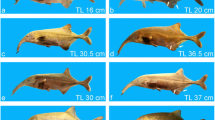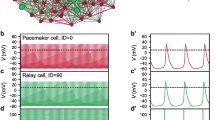Summary
The effects of gonadal steroids upon the discharge frequencies of the weakly electric fishApteronotus rostratus were examined. Androgens elicited frequency decreases, while estrogens had no effect. The androgen-induced decreases occurred with very short latencies and lasted only for several hours. The medullary nucleus that controls the discharge frequencies of these animals was subsequently isolated in an in vitro preparation. The effects of steroids were tested on the isolated pacemaker, and were found to be similar to those seen in intact animals. Thus, steroid effects upon discharge frequencies appear to be a consequence of direct effects upon the pacemaker. The short time course of the response suggests non-genomic effects of steroids upon neuronal activity in the pacemaker.
Similar content being viewed by others
References
Bardin CW, Catterall JF (1981) Testosterone: a major determinant of extragenital sexual dimorphism. Science 211: 1285–1294
Bass AH, Hopkins CD (1983) Hormonal control of sexual differentiation: changes in electric organ discharge waveform. Science 220:971–974
Bell CC, Libouban S, Szabo T (1982) Central pathways of the electric organ discharge command in mormyrid fish. Soc Neurosci Abstr VIII: 609
Bennett MVL, Pappas GD, Alijure E, Nakajima Y (1967a) Physiology and ultrastructure of electrotonic junctions. II. Spinal and medullary electromotor nuclei in mormyrid fish. J Neurophysiol 30:180–208
Bennett MVL, Pappas GD, Gimenez M, Nakajima Y (1967b) Physiology and ultrastructure of electrotonic junctions. IV. Medullary and electromotor nuclei in gymnotoid fish. J Neurophysiol 30:236–300
Bullock TH (1969) Species differences in effects of electroreceptor input on electric organ pacemakers and other aspects of behavior in gymnotoid fish. Brain Behav Evol 2:85–118
Bullock TH, Hamstra RH, Scheich H (1972) The jamming avoidance response of high frequency electric fish. J Comp Physiol 77:1–48
Bullock TH, Behrend K, Heiligenberg W (1975) Comparison of the jamming avoidance response in gymnotoid and gymnarchid electric fish: A case of convergent evolution of behavior and its sensory basis. J Comp Physiol 103:97–121
Cross BA, Dyer RG (1972) Ovarian modulation of unit activity in the anterior hypothalamus of the cyclic rat. J Physiol (Lond) 222:25
Elekes K, Szabo T (1981) Comparative synaptology of the pacemaker nucleus in the brain of weakly electric fish (Gymnotidae). In: Szabo T, Czeh G (eds) Adv Physiol Sci, vol 31. Sensory physiology of aquatic lower vertebrates. Pergamon Press, Budapest, pp 107–127
Enger PS, Szabo T (1968) Effects of temperature on discharge rate of the electric organ of some gymnotoids. Comp Biochem Physiol 27:625–627
Erulkar SD, Kelley DB, Jurman ME, Zemlen FP, Schneider GT, Krieger NR (1981) Modulation of the neural control of the clasp reflex inXenopus laevis by androgens: a multidisciplinary study. Proc Natl Acad Sci USA 78:5876–5800
Heiligenberg W (1977) Principals of electrolocation and jamming avoidance in electric fish. Springer, Berlin Heidelberg New York
Heiligenberg W, Finger T, Matsubara J, Carr C (1981) Input to the medullary pacemaker nucleus in the weakly electric fishEigenmannia (Sternopygidae, Gymnotiformes). Brain Res 211:418–423
Hopkins CD (1972) Sex differences in electric signaling in an electric fish. Science 176:1035–1037
Hopkins CD (1974) Electric communication in the reproductive behavior ofSternopygus macrurus (Gymnotoidei). Z Tierpsychol 35:518–535
Hopkins CD (1977) Electric communication. In: Sebeok T (ed) How animals communicate. Indiana University Press, Bloomington, pp 263–289
Hopkins CD (1981) On the diversity of electric signals in a community of mormyrid electric fish in West Africa. Am Zool 21:211–222
Hopkins CD, Heiligenberg W (1978) Evolutionary designs for electric signals and electroreceptors in gymnotoid fishes of Surinam. Behav Ecol Sociobiol 3:113–134
Hopkins CD, Bass AH (1981) Temporal coding of species recognition signals in an electric fish. Science 213:85–87
Kawakami M, Terasawa E, Ibuki T, Manaka M (1971) In: Sawyer CH, Gorski RA (eds) Steroid Hormones and Brain Function. UCLA Forum in Medical Sciences, 15th. University of California Press, Los Angeles, pp 79–97
Kelly MJ, Moss RL, Dudley CA, Fawcett CP (1977) The specificity of the response of preoptic septal area neurons to estrogen: 17α vs 17β-estradiol and the response of extrahypothalamic neurons. Exp Brain Res 30:43–52
Kendrick KM, Drewett RF (1979) Testosterone reduces refractory period of stria terminalis neurons in the rat brain. Science 204:877–879
Matsubara J (1981) Neural correlates of a nonjammable electrolocation system. Science 211:722–725
Matsubara J, Heiligenberg W (1978) How well do electric fish electrolocate under jamming? J Comp Physiol 125:285–290
Meyer JH (1983) Steroid influences upon the discharge frequencies of a weakly electric fish. J Comp Physiol 153:29–37
Ozon R (1972) Androgens in fishes, amphibians, reptiles, and birds. In: Idler DR (ed) Steroids in nonmammalian vertebrates. Academic Press, New York London, pp 328–389
Szabo T (1961) Anatomo-physiologie des centres nerveux spécifiques de quelques organes électriques. In: Chagas C, Paes de Carvalho, A (eds) Bioelectrogenesis. Elsevier, Amsterdam, pp 185–201
Szabo T, Enger PS (1964) Pacemaker activity of the medullary command nucleus controlling electric organs in high-frequency gymnotoid fish. Z Vergl Physiol 49:285–300
Tokunaga A, Ekert K, Sandri C, Bennett MVL (1980) Cell types and synaptic organization of the medullary electromotor nucleus in a constant frequency weakly electric fish,Sternarchus albifrons. J Comp Neurol 192:407–426
Watanabe A, Takeda K (1963) The change of discharge frequency by A.C. stimulus in a weak electric fish. J Exp Biol 40:57–66
Yagi K (1973) Changes in firing rates of single preoptic and hypothalamic units following an intravenous administration of estrogen in the castrated female rat. Brain Res 53:343–352
Author information
Authors and Affiliations
Rights and permissions
About this article
Cite this article
Meyer, J.H. Steroid influences upon discharge frequencies of intact and isolated pacemakers of weakly electric fish. J. Comp. Physiol. 154, 659–668 (1984). https://doi.org/10.1007/BF01350219
Accepted:
Issue Date:
DOI: https://doi.org/10.1007/BF01350219




